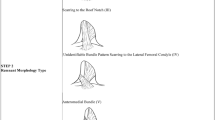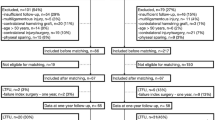Abstract
Purpose
A cohort study was conducted to evaluate the correlation of anterior cruciate ligament (ACL) remnant volume with preoperative status and postoperative outcome of the patients after a remnant-preserving double-bundle (DB) ACL reconstruction.
Methods
Eighty-eight patients of 105 unilateral DB anatomic ACL reconstructions performed between 2006 and 2008 were followed up for 24 months or more. They were evaluated with regard to preoperative knee laxity data under anaesthesia. Postoperative outcome was evaluated based on knee extension and flexion strength, manual laxity tests, KT measurements, etc. Overall knee condition and sports performance were evaluated with Lysholm knee score and subjective rating scale. Overall correlation of the remnant volume with the preoperative and postoperative evaluation was assessed. Then, the patients were divided into three subgroups based on the remnant volume (remnant volume: ≦30, 35–55 and ≦60 %). The evaluation was performed and analysed statistically among the three subgroups.
Results
Generally, preoperative laxity tests showed a weak correlation with the ACL remnant volume. Postoperative knee stability also indicated a weak correlation with the ACL remnant volume. Statistical analyses revealed that there were significant differences among the three groups regarding age at surgery, preoperative period, number of giving-way and preoperative KT measurements. Postoperatively, there were significant differences in Lachman test, KT measurements, Lysholm knee scale, subjective and sports performance recovery scores. As the clinical relevance, the study suggests that the remnant volume will be important as a background of preoperative condition and a predictor of operative outcome for each patient and that a remnant preserving surgery may not be simply better than a non-preserving technique with regard to subjective evaluation and sports performance recovery.
Conclusion
The preoperative condition of patients with ACL injury was different depending upon the remnant volume. The remnant volume was also weakly correlated with the postoperative outcome regarding objective stability and subjective recovery.
Level of evidence
Retrospective cohort study, Level III.



Similar content being viewed by others
References
Ahn JH, Lee YS, Ha HC (2009) Anterior cruciate ligament reconstruction with preservation of remnant bundle using hamstring autograft: technical note. Arch Orthop Trauma Surg 129:1011–1015
Ayeni OR, Chahal M, Tran MN, Sprague S (2012) Pivot shift as an outcome measure for ACL reconstruction: a systematic review. Knee Surg Sports Traumatol Arthrosc doi:10.1007/s00167-011-1860-y
Bali K, Dhillon MS, Vasistha RK, Kakkar N, Chana R, Prabhakar S (2012) Efficacy of immunohistological methods in detecting functionally viable mechanoreceptors in the remnant stumps of injured anterior cruciate ligaments and its clinical importance. Knee Surg Sports Traumatol Arthrosc 20:75–80
Crain EH, Fithian DC, Paxton EW, Luetzow WF (2005) Variation in anterior cruciate ligament scar pattern: does the scar pattern affect anterior laxity in anterior cruciate ligament-deficient knees? Arthroscopy 21:19–24
Daniel DM, Stone ML, Sachs R, Malcom L (1985) Instrumented measurement of anterior knee laxity in patients with acute anterior cruciate ligament disruption. Am J Sports Med 13:401–407
Dhillon MS, Bali K, Vasistha RK (2010) Immunohistological evaluation of proprioceptive potential of the residual stump of injured anterior cruciate ligaments (ACL). Int Orthop 34:737–741
Georgoulis AD, Pappa L, Moebius U, Malamou-Mitsi V, Pappa S, Papageorgiou CO, Agnantis NJ, Soucacos PN (2001) The presence of proprioceptive mechanoreceptors in the remnants of the ruptured ACL as a possible source of re-innervation of the ACL autograft. Knee Surg Sports Traumatol Arthrosc 9:364–368
Hara K, Mochizuki T, Sekiya I, Yamaguchi K, Akita K, Muneta T (2009) Anatomy of normal human anterior cruciate ligament attachments evaluated by divided small bundles. Am J Sports Med 37:2386–2391
Hefti F, Drobny T, Hackenbruch W, Kipfer WC, Holzach P, Lakob RP, Müller WE, Stäubli H-U (1990) Evaluation of knee ligament injuries: the OAK and IKDC form. In: Jakob RP, Stäubli H-U (eds) The knee and the cruciate ligament. Springer, Berlin, pp 134–139
Kim SJ, Jo SB, Kim TW, Chang JH, Choi HS, Oh KS (2009) A modified arthroscopic anterior cruciate ligament double-bundle reconstruction technique with autogenous quadriceps tendon graft: remnant-preserving technique. Arch Orthop Trauma Surg 129:403–407
Lee BI, Kwon SW, Kim JB, Choi HS, Min KD (2008) Comparison of clinical results according to amount of preserved remnant in arthroscopic anterior cruciate ligament reconstruction using quadrupled hamstring graft. Arthroscopy 24:560–568
Lee BI, Min KD, Choi HS, Kwon SW, Chun DI, Yun ES, Lee DW, Jin SY, Yoo JH (2009) Immunohistochemical study of mechanoreceptors in the tibial remnant of the ruptured anterior cruciate ligament in human knees. Knee Surg Sports Traumatol Arthrosc 17:1095–1101
Leung KK, Yu JK, Luo H, Ao YF, Wang JQ, Cui GQ, Hu YL, Gong X, Wang YJ, Zhang JY, Liu YL (2012) The position of the posterolateral bundle femoral tunnel during arthroscopic double-bundle anterior cruciate ligament reconstruction: a cadaveric study. Knee Surg Sports Traumatol Arthrosc 20:75–80
Lysholm J, Gillquist J (1982) Evaluation of knee ligament surgery results with special emphasis on use of a scoring scale. Am J Sports Med 10:150–154
Maeda S, Ishibashi Y, Tsuda E, Yamamoto Y, Toh S (2011) Intraoperative navigation evaluation of tibial translation after resection of anterior cruciate ligament remnants. Arthroscopy 27:959–964
Mochizuki T, Muneta T, Nagase T, Shirasawa S, Akita KI, Sekiya I (2006) Cadaveric knee observation study for describing anatomic femoral tunnel placement for two-bundle anterior cruciate ligament reconstruction. Arthroscopy 22:356–361
Muneta T, Ezura Y, Sekiya I, Yamamoto H (1996) Anterior knee laxity and loss of extension after anterior cruciate ligament injury. Am J Sports Med 24:603–607
Muneta T, Sekiya I, Ogiuchi T, Yagishita K, Yamamoto H, Shinomiya K (1998) Objective factors affecting overall subjective evaluation of recovery after anterior cruciate ligament reconstruction. Scand J Med Sci Sports 8:283–289
Muneta T, Koga H, Mochizuki T, Ju YJ, Hara K, Nimura A, Yagishita K, Sekiya I (2007) A prospective randomized study of 4-strand semitendinosus tendon anterior cruciate ligament reconstruction comparing single-bundle and double-bundle techniques. Arthroscopy 23:618–628
Muneta T, Hara K, Ju YJ, Mochizuki T, Morito T, Yagishita K, Sekiya I (2010) Revision anterior cruciate ligament reconstruction by double-bundle technique using multi-strand semitendinosus tendon. Arthroscopy 26:769–781
Nakamae A, Ochi M, Deie M, Adachi N, Kanaya A, Nishimori M, Nakasa T (2010) Biomechanical function of anterior cruciate ligament remnants: how long do they contribute to knee stability after injury in patients with complete tears? Arthroscopy 26:1577–1585
Piefer JW, Pflugner TR, Hwang MD, Lubowitz JH (2012) Anterior cruciate ligament femoral footprint anatomy: systematic review of the 21st century literature. Arthroscopy doi: 10.1016/j.arthro.2011.11.026
Tegner Y, Lysholm J (1985) Rating systems in the evaluation of knee ligament injuries. Clin Orthop Relat Res 198:43–49
van Eck CF, Schreiber VM, Mejia HA, Samuelsson K, van Dijk CN, Karlsson J, Fu FH (2010) “Anatomic” anterior cruciate ligament reconstruction: a systematic review of surgical techniques and reporting of surgical data. Arthroscopy 26(Suppl):S2–S12
Yamazaki J, Muneta T, Koga H, Sekiya I, Ju YJ, Morito T, Yagishita K (2011) Radiographic description of femoral tunnel placement expressed as intercondylar clock time in double-bundle anterior cruciate ligament reconstruction. Knee Surg Sports Traumatol Arthrosc 19:418–423
Yasuda K, Kondo E, Ichiyama H, Kitamura N, Tanabe Y, Tohyama H, Minami A (2004) Anatomic reconstruction of the anteromedial and posterolateral bundles of the anterior cruciate ligament using hamstring tendon grafts. Arthroscopy 20:1015–1025
Yasuda K, Tanabe Y, Kondo E, Kitamura N, Tohyama H (2010) Anatomic double-bundle anterior cruciate ligament reconstruction. Arthroscopy 26(Suppl):S21–S34
Yasuda K, Kondo E, Kitamura N, Kawaguchi Y, Kai S, Tanabe Y (2012) A pilot study of anatomic double-bundle anterior cruciate ligament reconstruction with ligament remnant tissue preservation. Arthroscopy 28:343–353
Zaffagnini S, Bruni D, Marcheggiani Muccioli GM, Bonanzinga T, Lopomo N, Bignozzi S, Marcacci M (2011) Single-bundle patellar tendon versus non-anatomical double-bundle hamstrings ACL reconstruction: a prospective randomized study at 8-year minimum follow-up. Knee Surg Sports Traumatol Arthrosc 19:390–397
Acknowledgments
We all appreciate Ms. Miyoko Ojima for her superb help in data collection.
Author information
Authors and Affiliations
Corresponding author
Rights and permissions
About this article
Cite this article
Muneta, T., Koga, H., Ju, YJ. et al. Remnant volume of anterior cruciate ligament correlates preoperative patients’ status and postoperative outcome. Knee Surg Sports Traumatol Arthrosc 21, 906–913 (2013). https://doi.org/10.1007/s00167-012-2023-5
Received:
Accepted:
Published:
Issue Date:
DOI: https://doi.org/10.1007/s00167-012-2023-5




